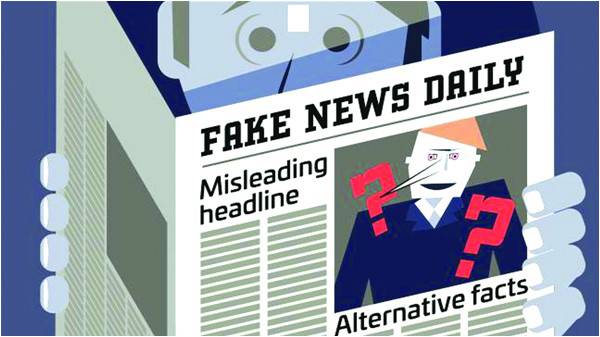
In today’s world, journalism is facing multifarious challenges and they have come mostly with fast-changing technology. In the West, print editions are fighting for survival and, in many cases, they have altogether disappeared. These threats are understandable since technological advancements have changed the lives of people to an unimaginable extent.
Journalism is fighting to stay relevant as an average reader believes himself to be a journalist with social media at his fingertips to disseminate information. This is what hardened journalists, who have been in the profession for a long time and have presided over successful newspaper models worldwide, do not agree with. For them, there is no alternative to journalism when it is real.
Threats to journalism due to social media and the readers’ dependence on it were discussed at length at this year’s Global Editors Network summit in Lisbon from May 30 to June 1, 2018. From how the newspapers need to integrate with a new model that is digital and data-based to the challenges thrown up by the use of social media and particularly fake news, the participants exuded confidence that it was the real time journalism that would survive since the reader has an appetite to read real news. US President Donald Trump’s oft-repeated jibe at what he calls “fake news” dominated the discussions. Some expressed reservation in not linking news with fake and at the most calling it “false.” “News can never be fake, call it fake information,” quipped one. “It has been turned into a weapon to mean anything a particular person doesn’t like”.
Social media platforms like Google, Facebook and Twitter were focus of the discussions since they generate most of the content that does not go through the process of fact-checking and editing. The overwhelming view was that both Facebook and Google would have to take responsibility of what the platforms are churning out as they also are publishers. But they don’t take this responsibility seriously. While in the West social media platforms like Facebook are mostly used and not misused, in the developing world it is used against individuals by individuals and the menace of fake accounts and pages has not been controlled.
Already under pressure for the data leaks, Facebook is struggling to resurrect its credibility. According to a survey by Tow Centre for Digital Journalism, these platforms have not been able to build trust among people in combating fake news. The figures are self-explanatory: 76 percent respondents have said that Facebook is not doing enough while as 71 have said the same in case of Twitter and 65 percent for Google. In ‘just enough’ category 14 percent have said it about Facebook, 17 percent for Twitter and 21 percent for Google.
At the same time newsrooms have started adopting new strategies and the relationship has shifted since social media is seen as a “powerful” tool to enhance the reach, despite strong reservations journalists have against it.
In a research conducted by the same school in over 1,000 newsrooms in America and Canada, it became clear that these relationships have changed. “As many as 41 percent of the newsrooms surveyed said they made major changes to news production in response to the growth of social media platforms while 42 percent admitted to minor changes. Rather surprisingly, given all the bad press platforms have been getting lately, 50 percent of the respondents said that platforms have strengthened their relationship with audiences. 56 percent of respondents said platforms should take a great deal or quite a bit of responsibility for financially supporting journalism. And 86 percent of the respondents said that platforms have decreased trust in journalism,” says the research.
Another research conducted by Kantar shows a decline of trust in social media and online outlets primarily because of fake news. Out of around 8,000 people, they found that newspapers, magazines and TV news outlets had retained a greater measure of public trust than digital outlets. Overall, 58 percent of those surveyed said that as a result of becoming aware of fake news they had less trust in social media news stories about politics or elections.
For mainstream media, the figure was 24 percent. With reference to what Trump has been saying, Kantar concluded, “The efforts to brand ‘mainstream news media’ as ‘fake news’ have largely failed.”
Besides, many other issues confronting media, the threats to it and efforts to undermine its relevance came in for healthy discussions. For example, Washington Post columnist Margaret Sullivan said, “While journalists cannot become the opposition party to populists, journalists should neither be docile, keep their mouths shut, or continue business as usual.” With the ‘new media’ eating into the space and even the revenue of traditional media, a new space for embracing the changes has since been created. That is why one could see digital players, data managers, traditional editors and technological giants converging to give shape to a new and integrated newsroom. The chemistry between them is fast becoming a reality and this is probably because of the demands of the market.
What is interesting to see is that despite the emergence and reach of social media, which is easily available in a place like India due to cheap communication, traditional media has not lost its sheen. While in the West, hard copies are disappearing and the shift to digital editions is becoming a new reality, in places like India print is going to survive for a long time. Fake news emanating from social media platforms has, in a way, made the newspapers credible. Chief Executive Officer of Global Editors Network Bertrand Pecquerie has rightly said, “Robots will not replace journalists”.
But the challenge for them is to not to lose sight in competing with “breaking news” syndrome that will bring them at par with false information that is coming out of no mechanisms. Fact checking, contextualization and accuracy are tools that are the most important. Blurring the lines between news reporting and opinion reporting is an anathema to journalism. Impartiality is the only saving tool.
Journalism is fighting to stay relevant as an average reader believes himself to be a journalist with social media at his fingertips to disseminate information. This is what hardened journalists, who have been in the profession for a long time and have presided over successful newspaper models worldwide, do not agree with. For them, there is no alternative to journalism when it is real.
Threats to journalism due to social media and the readers’ dependence on it were discussed at length at this year’s Global Editors Network summit in Lisbon from May 30 to June 1, 2018. From how the newspapers need to integrate with a new model that is digital and data-based to the challenges thrown up by the use of social media and particularly fake news, the participants exuded confidence that it was the real time journalism that would survive since the reader has an appetite to read real news. US President Donald Trump’s oft-repeated jibe at what he calls “fake news” dominated the discussions. Some expressed reservation in not linking news with fake and at the most calling it “false.” “News can never be fake, call it fake information,” quipped one. “It has been turned into a weapon to mean anything a particular person doesn’t like”.
Social media platforms like Google, Facebook and Twitter were focus of the discussions since they generate most of the content that does not go through the process of fact-checking and editing. The overwhelming view was that both Facebook and Google would have to take responsibility of what the platforms are churning out as they also are publishers. But they don’t take this responsibility seriously. While in the West social media platforms like Facebook are mostly used and not misused, in the developing world it is used against individuals by individuals and the menace of fake accounts and pages has not been controlled.
Already under pressure for the data leaks, Facebook is struggling to resurrect its credibility. According to a survey by Tow Centre for Digital Journalism, these platforms have not been able to build trust among people in combating fake news. The figures are self-explanatory: 76 percent respondents have said that Facebook is not doing enough while as 71 have said the same in case of Twitter and 65 percent for Google. In ‘just enough’ category 14 percent have said it about Facebook, 17 percent for Twitter and 21 percent for Google.
At the same time newsrooms have started adopting new strategies and the relationship has shifted since social media is seen as a “powerful” tool to enhance the reach, despite strong reservations journalists have against it.
In a research conducted by the same school in over 1,000 newsrooms in America and Canada, it became clear that these relationships have changed. “As many as 41 percent of the newsrooms surveyed said they made major changes to news production in response to the growth of social media platforms while 42 percent admitted to minor changes. Rather surprisingly, given all the bad press platforms have been getting lately, 50 percent of the respondents said that platforms have strengthened their relationship with audiences. 56 percent of respondents said platforms should take a great deal or quite a bit of responsibility for financially supporting journalism. And 86 percent of the respondents said that platforms have decreased trust in journalism,” says the research.
Another research conducted by Kantar shows a decline of trust in social media and online outlets primarily because of fake news. Out of around 8,000 people, they found that newspapers, magazines and TV news outlets had retained a greater measure of public trust than digital outlets. Overall, 58 percent of those surveyed said that as a result of becoming aware of fake news they had less trust in social media news stories about politics or elections.
For mainstream media, the figure was 24 percent. With reference to what Trump has been saying, Kantar concluded, “The efforts to brand ‘mainstream news media’ as ‘fake news’ have largely failed.”
Besides, many other issues confronting media, the threats to it and efforts to undermine its relevance came in for healthy discussions. For example, Washington Post columnist Margaret Sullivan said, “While journalists cannot become the opposition party to populists, journalists should neither be docile, keep their mouths shut, or continue business as usual.” With the ‘new media’ eating into the space and even the revenue of traditional media, a new space for embracing the changes has since been created. That is why one could see digital players, data managers, traditional editors and technological giants converging to give shape to a new and integrated newsroom. The chemistry between them is fast becoming a reality and this is probably because of the demands of the market.
What is interesting to see is that despite the emergence and reach of social media, which is easily available in a place like India due to cheap communication, traditional media has not lost its sheen. While in the West, hard copies are disappearing and the shift to digital editions is becoming a new reality, in places like India print is going to survive for a long time. Fake news emanating from social media platforms has, in a way, made the newspapers credible. Chief Executive Officer of Global Editors Network Bertrand Pecquerie has rightly said, “Robots will not replace journalists”.
But the challenge for them is to not to lose sight in competing with “breaking news” syndrome that will bring them at par with false information that is coming out of no mechanisms. Fact checking, contextualization and accuracy are tools that are the most important. Blurring the lines between news reporting and opinion reporting is an anathema to journalism. Impartiality is the only saving tool.

